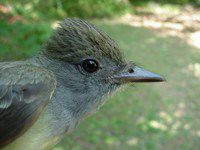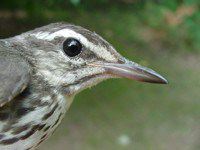
All text & photos © Hilton Pond Center
GIANT GARDENSLUG
- Slugs, for many people, are only slightly more appetizing than cockroaches, but they're still fascinating creatures. Most folks become aware of these slimy, soft-bodied creatures when they invade the home garden or greenhouse and snack on home-grown vegetables--an appropriate behavior since slugs are vegetarians. In the wild they eat fungi and decaying matter. At Hilton Pond Center, the most noticeable slug is the Giant Gardenslug (Limax maximus) shown above, which can stretch to lengths of six inches or more. This flexibility is enhanced by the absence of an external hard shell (or "valve") found in its close relatives, the land snails. However, the slug does have a soft, flexible shell embedded in its body; it is underneath the saddle-like structure (mantle) just behind the slug's head--which is at the right of the photo above. The Giant Gardenslug is not native to the U.S. and probably arrived from Europe with early settlers.
 Slugs are classified as Mollusca (the Mollusk class) along with land and marine univalves (including conchs, whelks, and pond snails), bivalves (such as clams and oysters), and--believe it or not--octopi and squid (which also have internal shells). The close-up photo above reveals two long eye stalks and shorter mouth tentacles that bear olfactory (smell) organs; just behind and below these is the mouth, which contains hard structures that rasp away plant material the slug can then ingest. Also visible is a large breathing hole that only occurs on the right side of the slug's body. Slugs are classified as Mollusca (the Mollusk class) along with land and marine univalves (including conchs, whelks, and pond snails), bivalves (such as clams and oysters), and--believe it or not--octopi and squid (which also have internal shells). The close-up photo above reveals two long eye stalks and shorter mouth tentacles that bear olfactory (smell) organs; just behind and below these is the mouth, which contains hard structures that rasp away plant material the slug can then ingest. Also visible is a large breathing hole that only occurs on the right side of the slug's body.
- Slugs are true hermaphrodites; each individual in the pair serves as both male and female when they mate by twining around each other. Each slug then lays a cluster of spherical gelatinous eggs that become transparent and allow a keen-eyed observer to see the developing larvae.
- Slugs patrol moist areas, using ventral muscles to glide along on a thin layer of slime that is left as a trail on vegetation. (The Giant Gardenslug leaves a trail of transparent, clear mucus.) Anyone who'd ever stepped barefoot on a slug knows this slime is almost impossible to wash off, and it also serves as a deterrent to predators.
|




